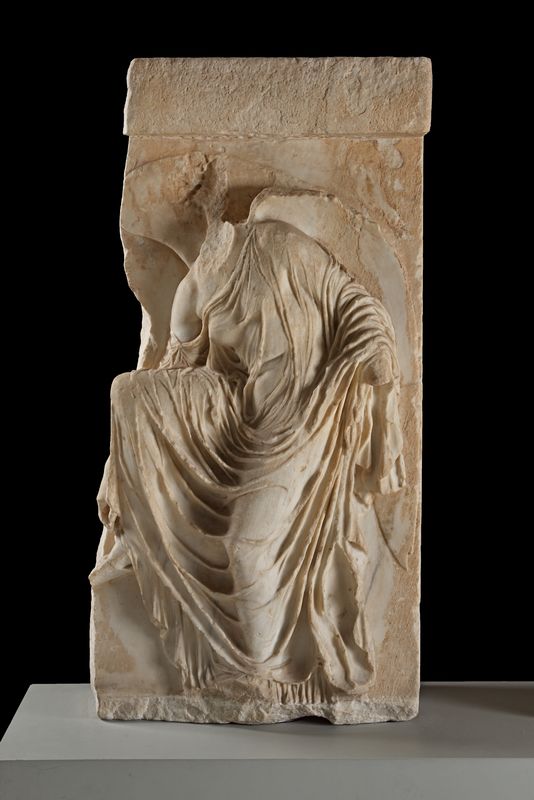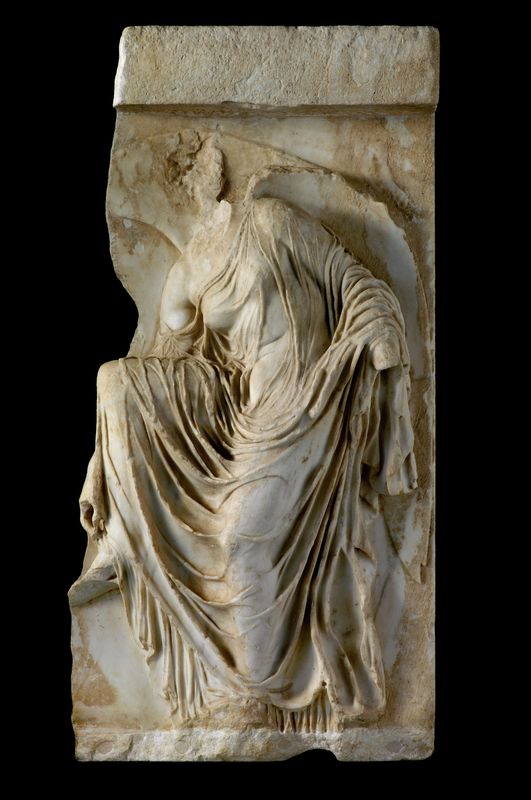Athena Nike Temple. Parapet. South slab. The "Sandalbinder"
Inventory number
Ακρ. 973
Artist
Agorakritos' workshop
Category
Architectural sculpture
Period
Classical Period
Date
Around 410 BC
Dimensions
Height: 1.06 m
Length: 0.52 m
Material
Marble from Penteli
Location
First Floor, West
Right part of a slab that has been regarded as belonging to the south side of the parapet of the Temple of Athena Nike. It was found in 1835 near the temple.
It depicts a winged Nike who adjusts or unbinds her sandal in order to walk barefoot in the sacred area of the temple of Athena, a gesture that gave her the conventional name the "Sandalbinder". Her transparent chiton, which clings to her body as if wet, slips down, leaving her right shoulder bare. The fabric of her himation clings to her lower body, draping down in large folds, while her face, no longer preserved, is framed by her wings.
Some researchers find similarities between this depiction of the Nike and those of Aphrodite and thus regard her presence on the south side of the parapet as an allusion to the Sanctuary of Aphrodite Pandemos, situated right below the temple of Athena Nike.
The parapet enclosed the three sides of the bastion, on which the temple was built. It consisted of slabs approximately one meter in height whose outer surfaces were decorated with relief scenes visible by those ascending the Acropolis. The holes preserved on the upper surface of these slabs indicate there was originally a metal railing, which further raised the height of the parapet.
The theme depicted on the parapet is a celebration of the military victories of the Athenians against their enemies, either Persians or other Greeks. The narrative is not continuous; instead it is composed of separate, individual scenes which – with slight variations – recur on each side of the parapet: winged Nikai lead bulls to sacrifice or hold weapons and adorn victory trophies with Greek or Persian armour. Among them sits goddess Athena, resting after victorious battles. The carving of the temple's sculptures was carried out by many different artists under the supervision of Agorakritos. These sculpted figures are highly representative of the end of the 5th cent. BC style called by archaeologists the "rich style".
In 1687 the temple and the parapet of Athena Nike were dismantled by the Ottomans and the material was used for the reinforcement of a gun emplacement and the fortification of the west side of the Acropolis against the attacks by the Venetians under the command of the general Francesco Morosini. Between 1835 and 1836 the gun emplacement was demolished and the Temple of Athena Nike was restored for the first time under the supervision of Ludwig Ross, the administrator of antiquities at the time. A second reconstruction was carried out in 1940, while a third was completed in 2010.
Πιττάκης, Κ.Σ., «Φυλλάδιον 28», Αρχαιολογική Εφημερίς 1842 (1842), σελ. 593, αρ.κατ. 1041
De Saulcy, F., M. de Saulcy, «Musée d' Athènes», Revue Archéologique 2e Année, No. 1, 1845, σελ. 272
Heller, B.K., Archäologisch-artistische Mittheilungen über die Ausgrabungen auf der Akropolis zu Athen 1835, 36 und 37, Nürnberg, 1852, σελ. 3, 7
Beulé, E., L'Acropole d'Athenes II, Paris, 1854, σελ. 255-258
Ross, L., Archäologische Aufsätze I: Ausgrabungsberichte aus Athen. Zur Kunstgeschichte und Topographie von Athen und Attika, Leipzig, 1855, σελ. 102
Overbeck, J., Geschichte der Griechischen Plastik, I, Leipzig, 1857, σελ. 286-288, εικ. 53
Beulé, M., L' Acropole d'Athènes, Paris, 1862, σελ. 139, 141-142
Breton, E., Athènes, Paris, 1862, σελ. 73-74
Michaelis, A., «Die Balustrade am Tempel der Athena Nike auf der Akropolis von Athen, Arch. Zeit», Archäologische Zeitung 20, 1862, σελ. 249-250
Leake, W.M., Topographie d' Athènes, Paris, 1869, σελ. 63
Kekulé von Stradonitz, R., Die Balustrade des Tempels der Athena Nike in Athen, Leipzig, 1869, σελ. 25, 29-30, πίν. III.N, αρ.κατ. 19
Sybel, L. von, Katalog der Sculpturen zu Athen, Marburg, 1881, σελ. 359, αρ.κατ. 4
Kekulé von Stradonitz, R., Die Reliefs an der Balustrade der Athena Nike, Stuttgart, 1881, σελ. 2, 8-9, 18, 20-21, πίν. IV.O, αρ.κατ. O
Petersen, E., «Βιβλιοκρισία του R. Kekulé, Die Reliefs an der Balustrade der Athena Nike,», Zeitschrift für die Österreichischen Gymnasien, 32, Wien, 1881, σελ. 264, 266
Friederichs, C., Wolters, P., Die Gipsabgüsse antiker Bildwerke, Berlin, 1885, σελ. 286-287
Le Bas, M.P., Reinach, S., Voyage Archéologique en Grèce et en Asie Mineure 1842-1844, σχολιασμένη έκδοση, Paris, 1888, σελ. 129, εικ. 12.III, αρ.κατ. III
Boettischer, A., Die Akropolis von Athen nach den Berichten der alten und den neusten Erforschungen, Berlin, 1888, σελ. 207-209, εικ. 92
Furtwängler, A., Meisterwerke der griechischen Plastik. Kunstgeschichtliche Untersuchungen, Leipzig/Berlin, 1893, σελ. 222 και υποσημ. 1
Overbeck, J., Geschichte der Griechischen Plastik, I, Leipzig, 1893-1894, σελ. 489, εικ. 125
Collignon, M., Histoire de la sculpture grecque II, Paris, 1897, σελ. 106-108, εικ. 54
Studniczka, F., Die Siegesgoettin, Leipzig, 1898, σελ. 22-23, εικ. 48, πίν. Χ
Petersen, E., Athen, Leipzig, 1908, σελ. 89
Sauerlandt, M., Griechische Bildwerke, Düsseldorf/Leipzig, 1911, σελ. VII-VIII, εικ. 64
Vollgraff, W., A propos du fronton oriental du temple de Zeus à Olympie, Mélanges Holleaux. Recueil de mémoires concernant l'antiquité, Paris, 1913, σελ. 302-304
Casson, S., Brooke, D., Catalogue of the Acropolis Museum. Sculpture and Architectural Fragments, with a section upon the Terracottas, II, Cambridge, 1921, σελ. 156-159, αρ.κατ. 12
Σωτηριάδης, Γ., Η Ακρόπολις και το Μουσείον αυτής, 1921, Αθήνα, σελ. 185, εικ. 48
Heberdey, R., «Die Komposition der Reliefs an der Balustrade der Athena Nike», Jahreshefte des Österreichischen Archäologischen Institutes in Wien 21-22, 1922-1924, σελ. 1, 3, 23-24, 53, 72-74, 81, εικ. 20
Blümel, C., Der Fries des Tempels der Athena Nike, Berlin, 1923, σελ. 19-23, εικ. VIII
Schrader, H., Phidias, Frankfurt am Mainz, 1924, σελ. 354, εικ. 319
Richter, G., «Neo-Attic Crater in the Metropolitan Museum of Art», Journal of Hellenic Studies 45, 1925, σελ. 204-207, εικ. 7 4a
Dinsmoor, W.B., «The Sculptured Parapet of Athena Nike», American Journal of Archaeology 30, 1926, σελ. 9-10, 12-13, 18, 27
Lawrence, A.W., Classical Sculpture, New York, 1927, σελ. 223, πίν. 72a
Τσούντας, Χ., Ιστορία της αρχαίας Ελληνικής Τέχνης, Αθήνα, 1928, σελ. 305-306
Möbius, H., «Zu Illissosfries und Nikebalustrade», Mitteilungen des Deutschen Archäologischen Instituts. Athenische Abteilung 53, 1928, σελ. 6, εικ. 1: II, III,
Carpenter, R., The Sculptures of the Nike Temple Parapet, Cambridge Massachusetts, 1929, σελ. 62-65, 73-74, 79-80, πίν. XXVII, XXVIII.2, XXIX, XXXIV.4, αρ.κατ. 12
Richter, G., The Sculpture and Sculptors of Greece, New York, 1929, σελ. 67-68, 138, εικ. 543
Carpenter, R., «The Sculptural Composotion of the Nike Parapet», American Journal of Archaeology 33, 1929, σελ. 474, 477
Rodenwaldt, G., Hege, W., L' Acropole, Paris, 1930, σελ. 54, εικ. 75b
Dinsmoor, W.B., «The Nike Parapet Once More», American Journal of Archaeology 34, 1930, σελ. 282, 286
Picard, C., F. Boissonas, L’Acropole d’Athenes, l’enceinte, l’entree, le bastion d’Athena Nike, les Propylees, Paris, 1930, σελ. 27, εικ. 42
Schoppa, H., «Beiträge zur attischen Vasenmalerei nach Meidias», Archäologischer Anzeiger 1935, σελ. 34-37
Gerke, F., Griechische Plastik in archaischer und klassischer Zeit, Zürich/Berlin, 1938, σελ. 248-249, εικ. 185
Picard, C., La Sculpture II. Période Classique - Ve siècle, Manuel d'Archéologie Grecque II. 2, Paris, 1939, σελ. 778, 781, εικ. 314
Blümel, C., «Der Fries des Tempels der Athena Nike in der attischen Kunst des 5. Jh. V. Chr.», Jahrbuch des Deutschen Archäologischen Instituts 65/66, 1950/51, σελ. 153-154
Crome, J.F., Die Skulpturen des Asklepiostempels von Epidauros, Berlin, 1951, σελ. 29 και υποσημ. 1
Lullies, R., Hirmer, M., Griechische Plastik von den Anfängen bis zum Ausgang des Hellenismus, München, 1956, σελ. 65-66, 101-102, εικ. 189
Dohrn, T., Attische Plastik vom Tode des Phidias bis zum Wirken der grossen Meister des IV. Jahrhunderts v. Chr., Krefeld, 1957, σελ. 24-25, 65
Buschor, E., Die Plastik der Griechen, Berlin, 1958, σελ. 79-80
Harrison, E.B., «New Sculpture from the Athenian Agora, 1959», Hesperia 29, 1960, σελ. 375
Fuchs, W., Die Vorbilder der neuattischen Reliefs, Jahrbuch des Deutschen Archäologischen Instituts: Ergänzungsheft 20, 1959, σελ. 7
Carpenter, R., Greek Sculpture, University of Chicago Press, 1961, σελ. 142-144, 146-147, εικ. 23Α
Berve, H., Gruben, G., Hirmer, M., Griechische Tempel und Heiligtümer, München, 1961, σελ. 181, εικ. 31
Bieber, Μ., The Sculpture of the Hellenistic Age, New York, 1961, σελ. 179, 183, εικ. 797
Καρούζος, Χ. (επιμ.), «Χαριστήριον εις Αναστάσιον Κ. Ορλάνδον», Αθήνα, 1965, σελ. 261
Schefold, K., Klassisches Griechenland, Baden-Baden, 1965, σελ. 162
Schlörb, Β., Timotheos, Jahrbuch des Deutschen Archäologischen Instituts: Ergänzungsheft 22, 1965, σελ. 41, 66, εικ. 12
Adam, Sh., «The Technique of Greek Sculpture in the Archaic and Classical Periods», Annual of the British School at Athens, Suppl. 3, 1966, σελ. 56
Boardman, J., Dӧrig, J., Fuchs, W., Hirmer, M., Die griechische Kunst, München, 1966, σελ. 159-160, εικ. 221
Schefold, K., Die Griechen und ihre Nachbarn Propyläen Kunstgeschichte, I, Berlin, 1967, σελ. 186-187, εικ. 91, αρ.κατ. 91
Linfert, A., «Vier klassische Akrotere», Archäologischer Anzeiger 1968, σελ. 432
Schuchhardt, W.H., Griechische Kunst, Stuttgart, 1968, σελ. 121, 132, εικ. 85
Fuchs, W., Die Skulptur der Griechen, München, 1969, σελ. 445-446, εικ. 513
Δεσπίνης, Γ., Συμβολή στη μελέτη του έργου του Αγοράκριτου, Αθήνα, 1971, σελ. 171
Hopper, R.J., The Acropolis, London, 1971, σελ. 181
Croissant, F., «Une Aphrodite méconnue du début du IVe siècle», Bulletin de Correspondance Hellénique 95, 1971, σελ. 94-96, 98
Childs, W.A.P., «Prolegomena to a Lycian Chronology: the Nereid Monument from Xanthos», Opuscula Romana 9, 1973, σελ. 12, 109, εικ. 97
Hölscher, T., «Die Nike der Messenier und Naupaktier in Olympia. Kunst und Geschichte im späten 5. Jahrhundert v. Chr.», Jahrbuch des Deutschen Archäologischen Instituts 89, 1974, σελ. 91 και υποσημ. 86
Μπρούσκαρη, Μ., Μουσείον Ακροπόλεως. Περιγραφικός κατάλογος, Αθήνα, 1974, σελ. 168, εικ. 333, αρ.κατ. 973
Robertson, M., A History of Greek Art, I-II, Cambridge, 1975, εικ. 117a
Bieber, Μ., Ancient Copies. Contributions to the History of Greek and Roman Art, 1977, σελ. 30-31, εικ. 47
Heres, H., «Fragment einer attischen Giebelskulptur des späten 5. Jahrhunderts v.u.Z.», Forschungen und Berichte: Staatliche Museen zu Berlin 18, 1977, σελ. 12 υποσημ. 23
Vierneisel-Schlörb, B., Klassische Skulpturen des 5. und 4. Jahrhunderts v. Chr. Staatliche Antikensammlungen und Glyptothek München: Katalog der Skulpturen, 2, München, 1979, σελ. 171 υποσημ. 12, 458
Mark, I., Nike and the Cult of Athena-Nike on the Athenian Acropolis, New York University, 1979, σελ. 181
Ridgway, B.S., Fifth Century Styles in Greek Sculpture, Princeton, 1981, σελ. 97-98, 133, εικ. 78
Haynes, D., Griechische Kunst und die Entdeckung der Freiheit, Mainz, 1982, σελ. 67, εικ. 65
Simon, E., «La decorazione architettonica del tempietto di Atena Nike sull' Acropoli di Atene», Museum Patavinum 3, 1985, σελ. 285
Simon, E., «Τα γλυπτά του ναού και του θωρακείου της Αθηνάς Νίκης», Αρχαιογνωσία 4, 1985, σελ. 26, εικ. 8
Burn, L., The Meidias Painter, Oxford, 1987, σελ. 10-11
Simon, E., Zur Sandalenlöserin der Nikebalustrade, στο E. Schmidt, Kanon. Festschrift Ernst Berger. Fünfzehntes Beiheft zur Halbjahresschrift Antike Kunst 15, Basel, 1988, σελ. 69-70, εικ. 20-21
Harrison, E.B., «Style Phases in Greek Sculpture from 450 to 370 BC», Πρακτικά του XII Διεθνούς Συνεδρίου Κλασικής Αρχαιολογίας, Αθήνα 4-10 Σεπτεμβρίου 1983, Γ, Αθήνα, 1988, σελ. 104
Meyer, M., Die griechischen Urkundenreliefs, Mitteilungen des Deutschen Archäologischen Instituts. Athenische Abteilung: Beiheft 13, Berlin, 1989, σελ. 40
Delivorrias, A., «Disiecta Membra: The Remarkable History of Some Sculptures from an Unknown Temple Marble», στο J. Paul Getty Museum (επιμ.), Marble. Art Historical and Scientific Perspectives on Ancient Sculpture, Malibu, 1990, σελ. 24-25, εικ. 15
Raftopoulou, E.G., «Étude iconographique sur un thème de la toreutique», Bulletin de Correspondance Hellénique 115, 1991, σελ. 265
LIMC VI, Nike, σελ. 865, αρ.κατ. 154a
Buitron-Oliver, D. (επιμ.), The Greek Miracle: Classical Sculpture from the Dawn of Democracy. The Fifth Century BC, National Gallery of Art, Washington, 22 November 1992 - 7 February 1993, The Metropolitan Museum of Art, New York, 11 March - 23 May 1993, Washington, 1992, σελ. 132-133, αρ.κατ. 25
Mark, I., «The Sanctuary of Athena Nike in Athens: Architectural Stages and Chronology», Hesperia Supplement 26, 1993, σελ. 90-91, εικ. 22a
Μπρούσκαρη, Μ., Το θωράκιο του Ναού της Αθηνάς Νίκης, Αρχαιολογική Εφημερίς 1998 Αθήνα, (1999), σελ. 128-134, εικ. 5-7, 79
Trianti, I., «Sculpture in Athens, Sixth-Fifth Century B.C.», στο N. Kaltsas (επιμ.), Athens-Sparta, Onassis Cultural Center, New York, December 6, 2006 - May 12, 2007, New York, 2006, σελ. 82, εικ. 6
Λεβέντη, Ι., Πόλη σε κρίση, Αθήνα, 2014, σελ. 100-106
Παντερμαλής, Δ., Ελευθεράτου, Σ., Βλασσοπούλου, Χ., Μουσείο Ακρόπολης. Οδηγός, Αθήνα, 2016, σελ. 251, 254-255, εικ. 312









